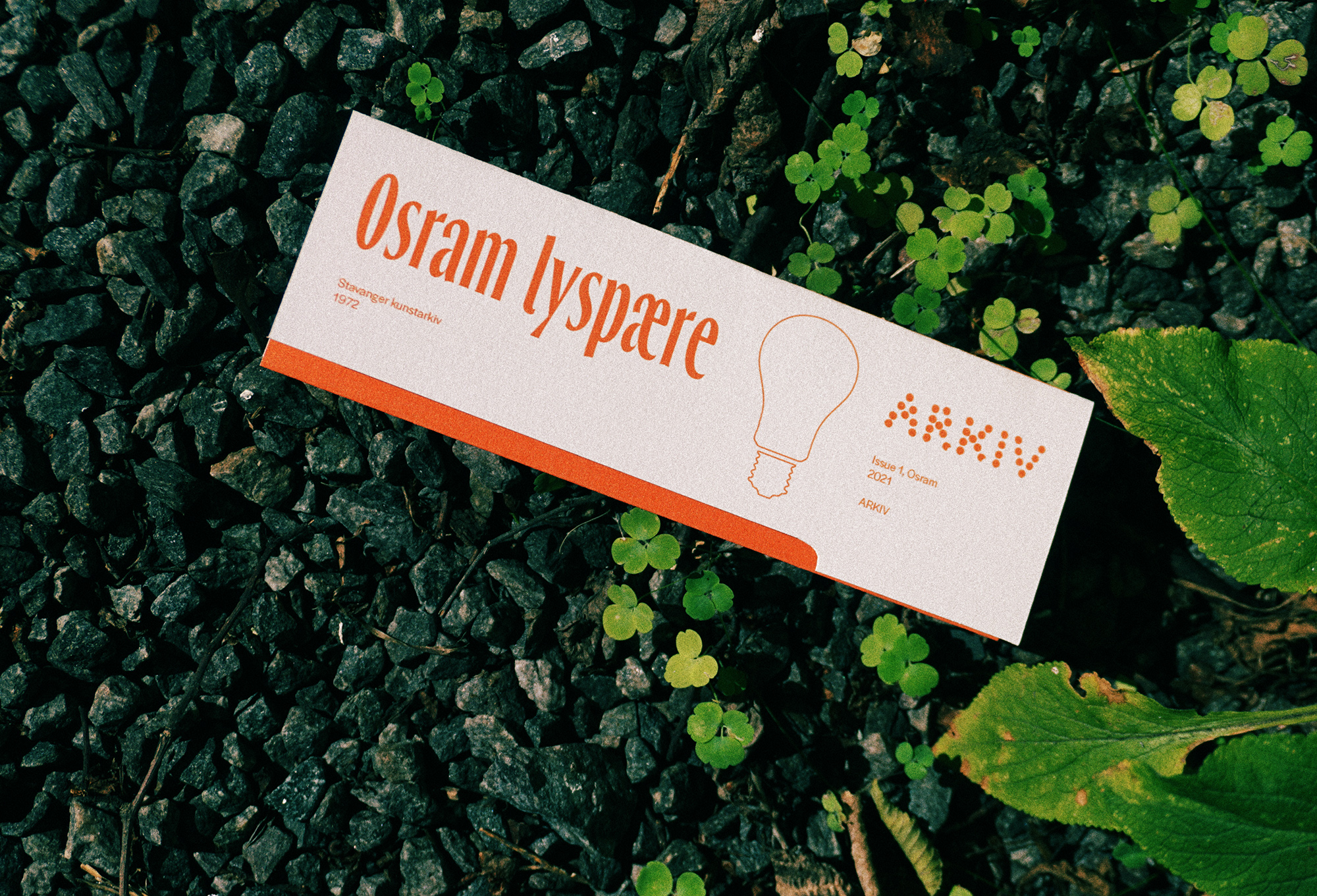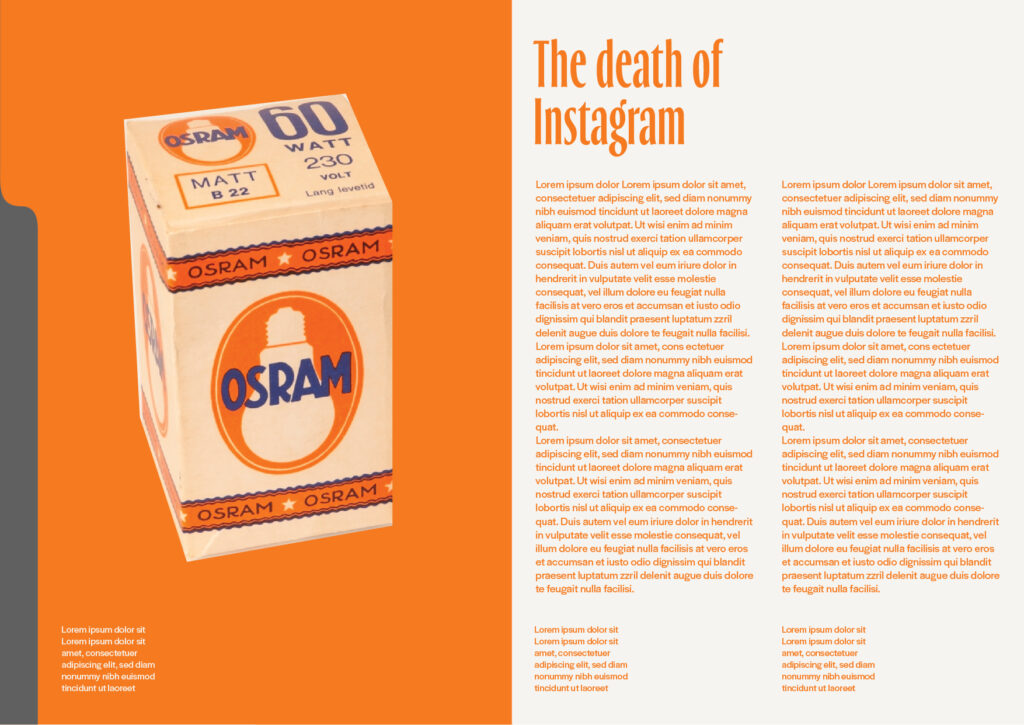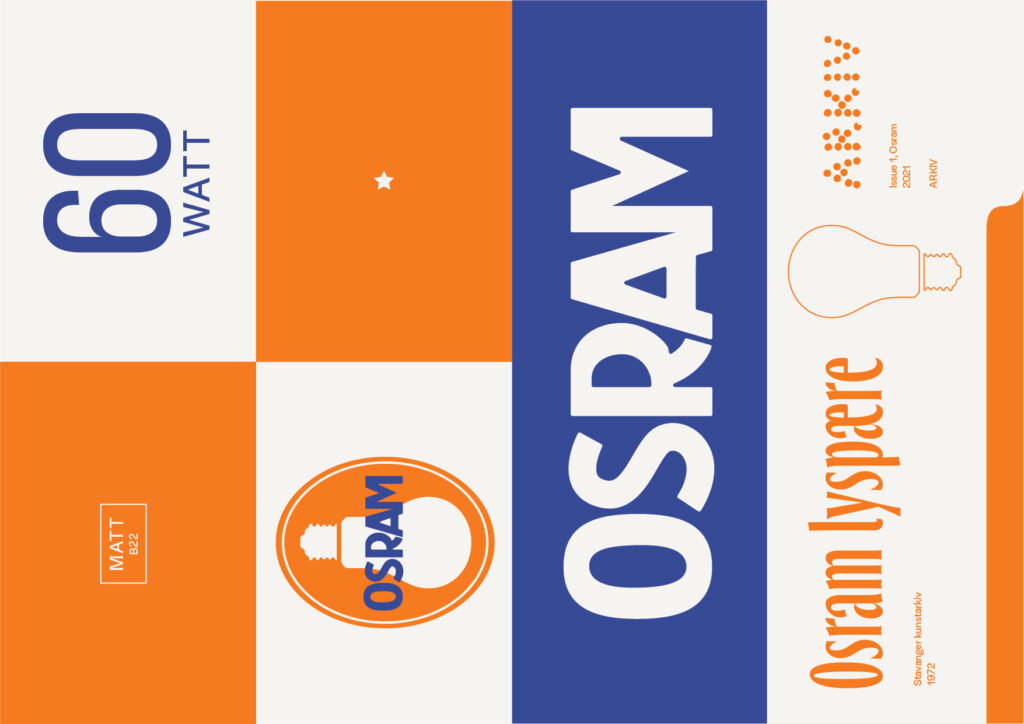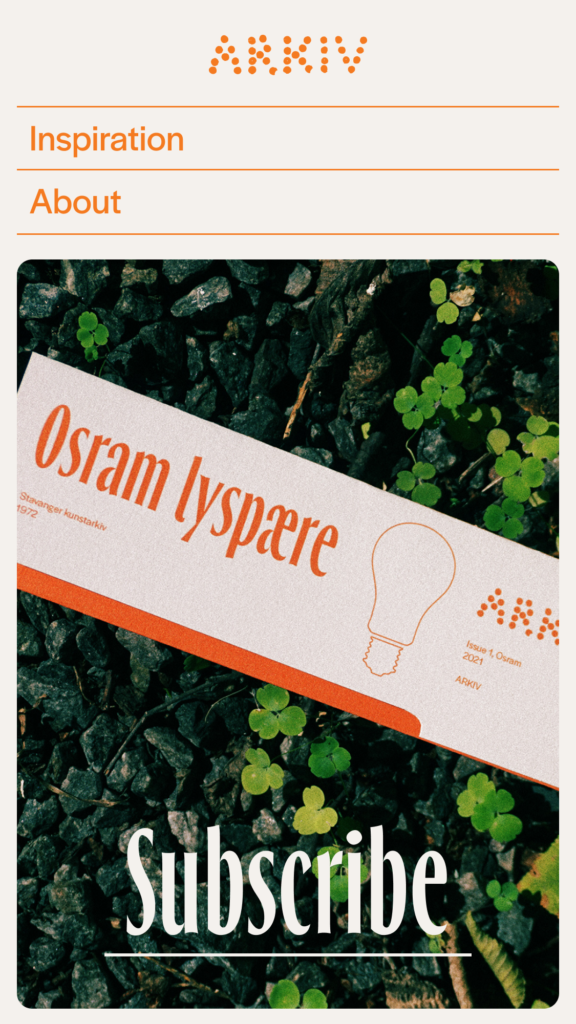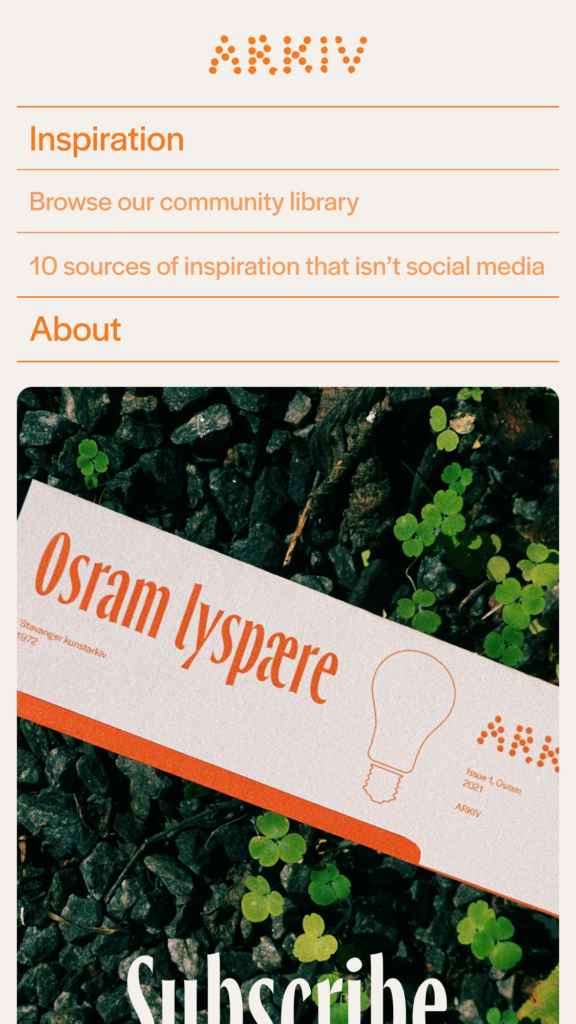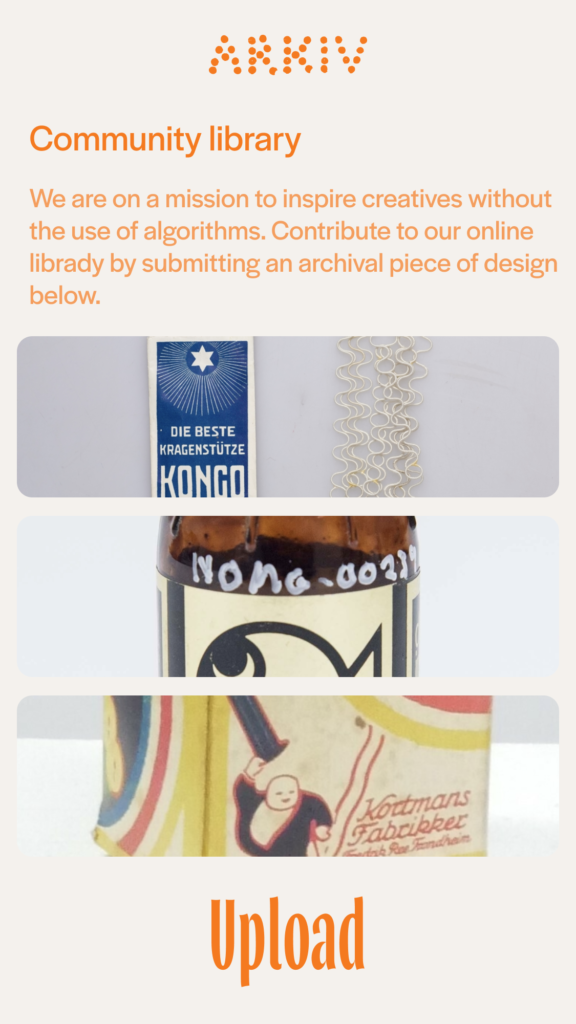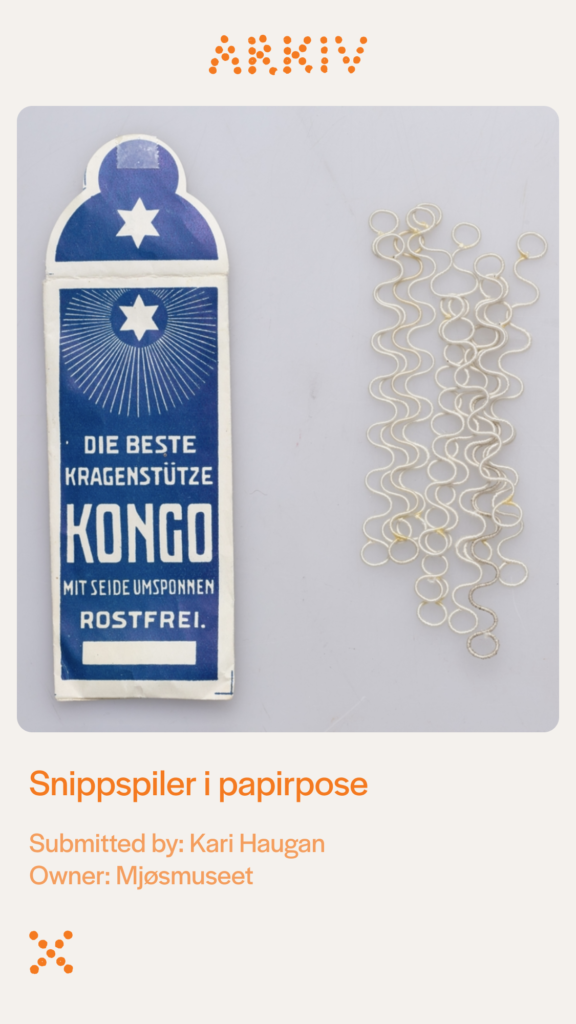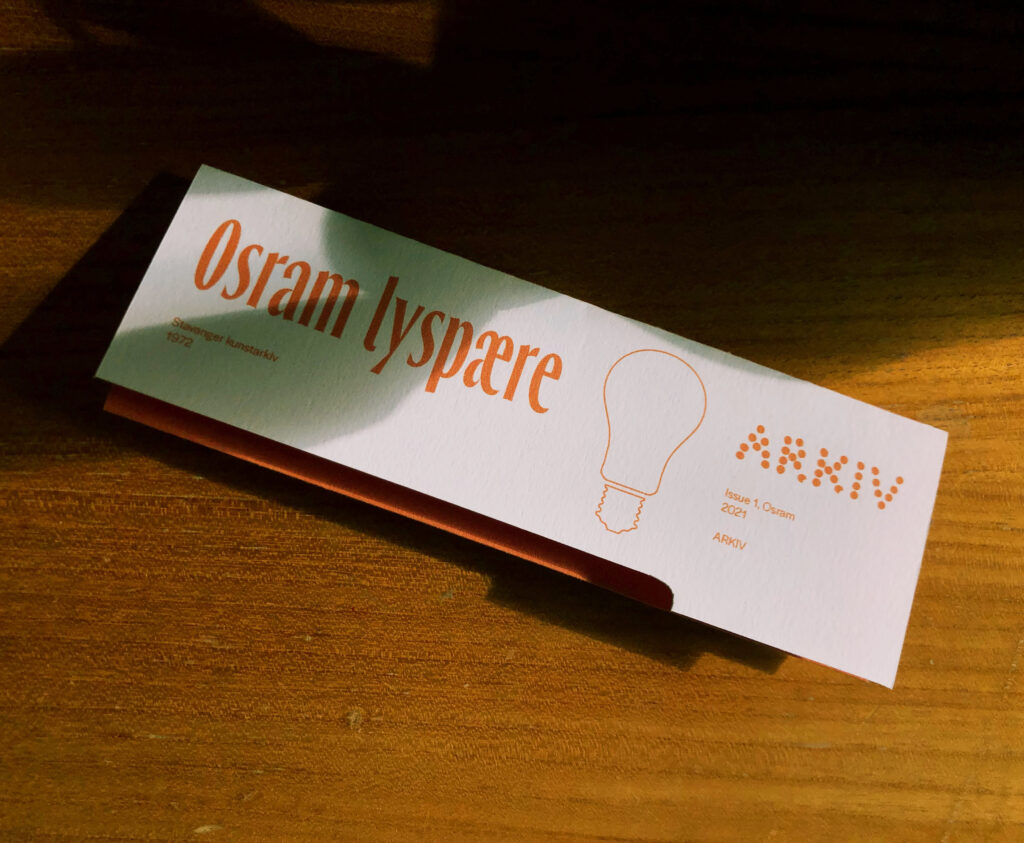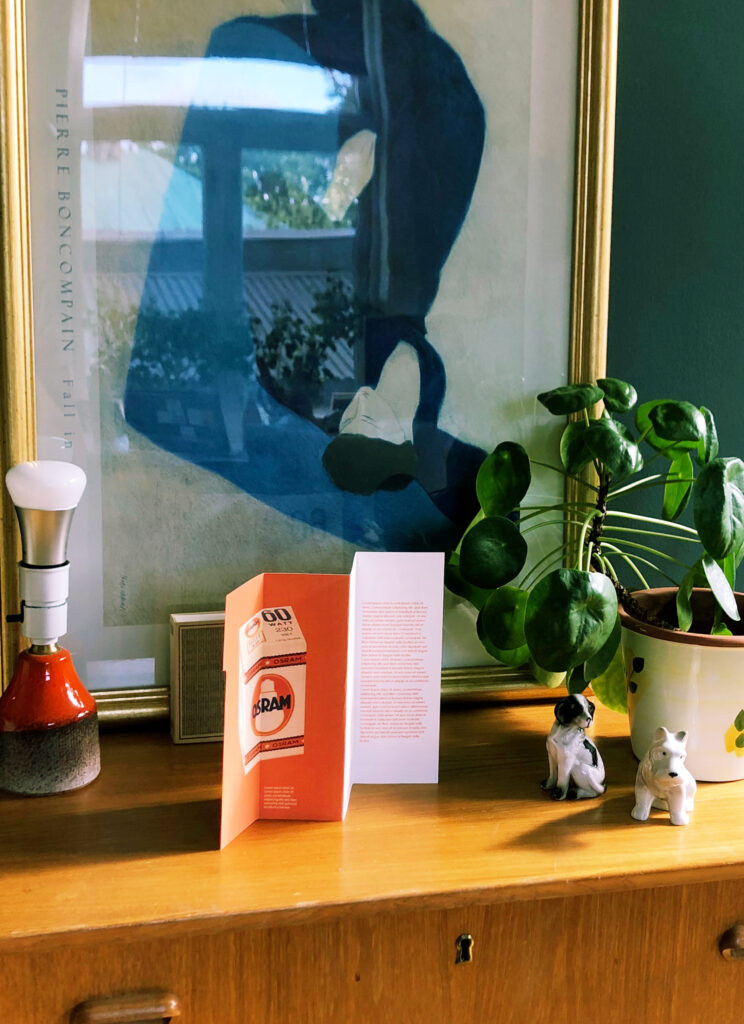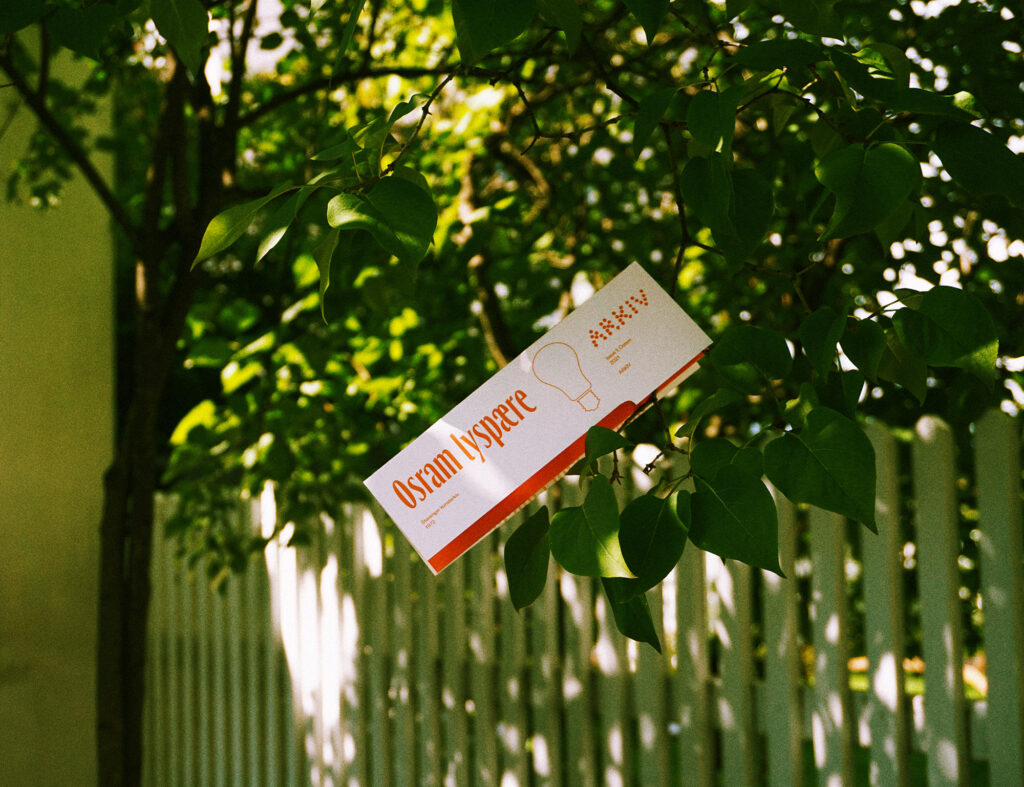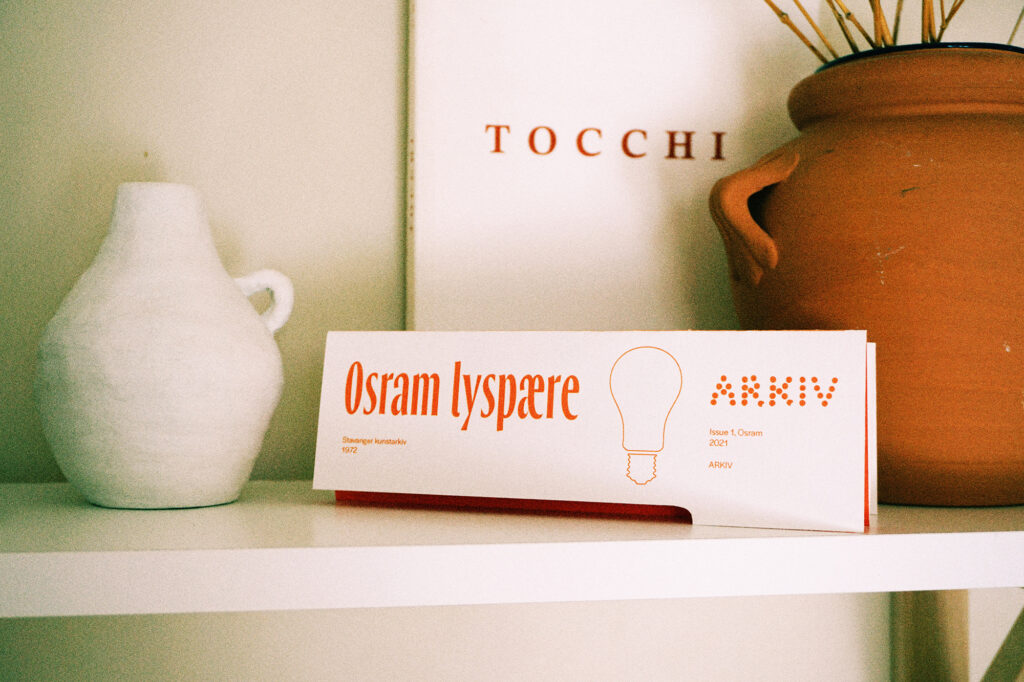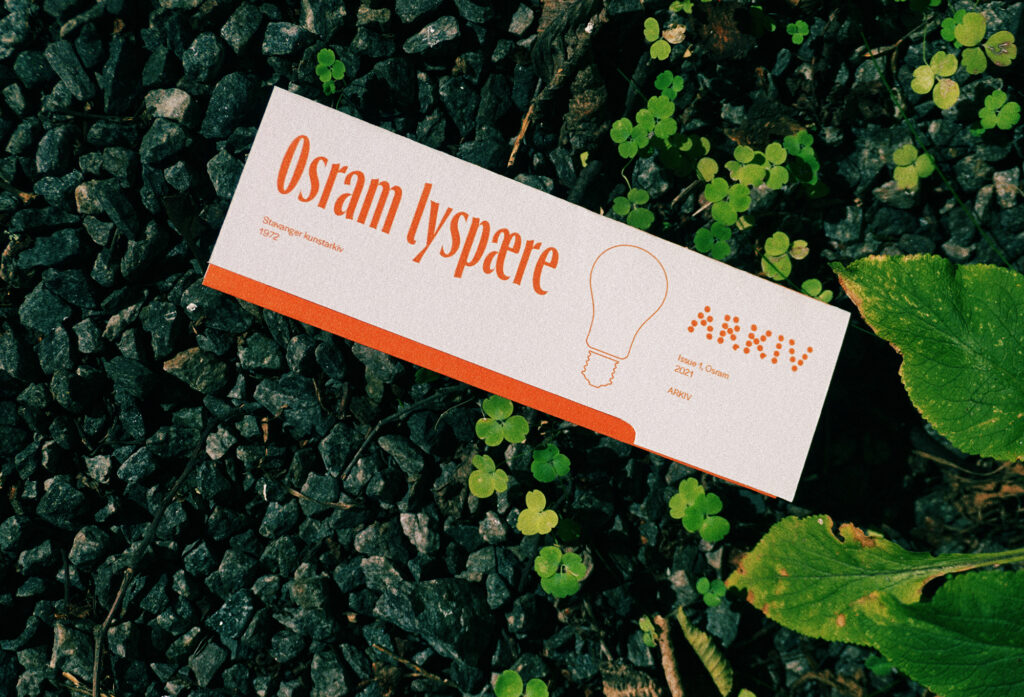Lecture notes
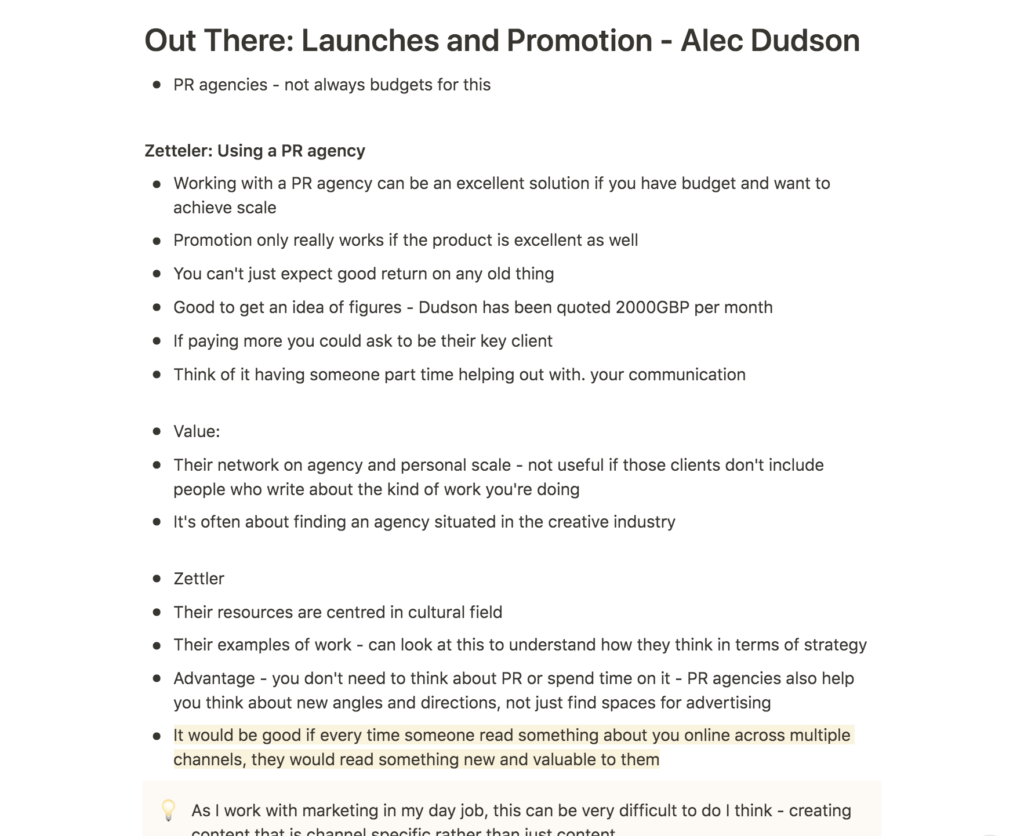
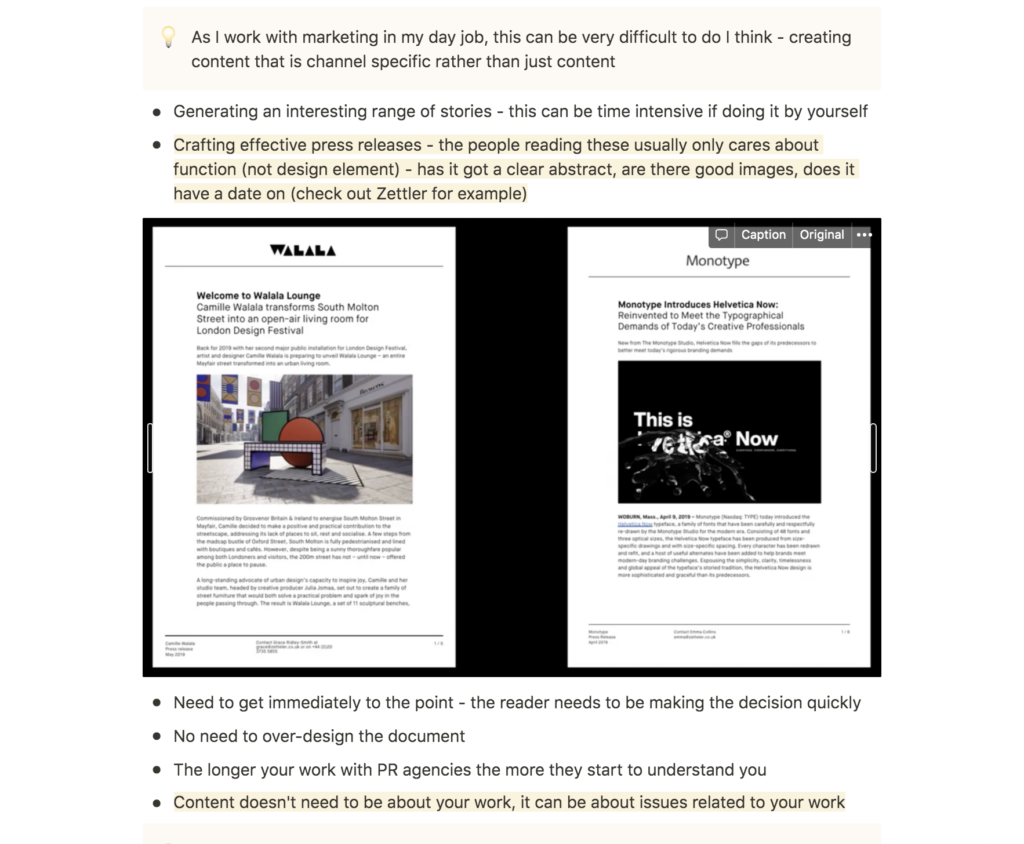

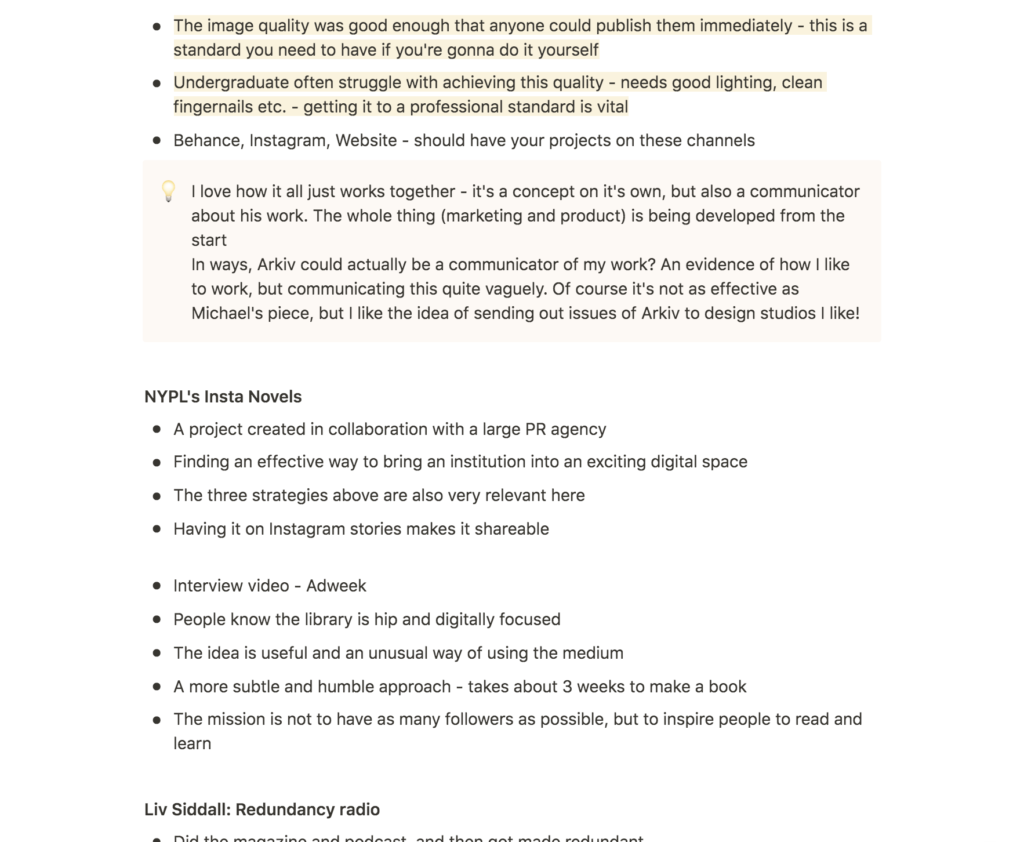
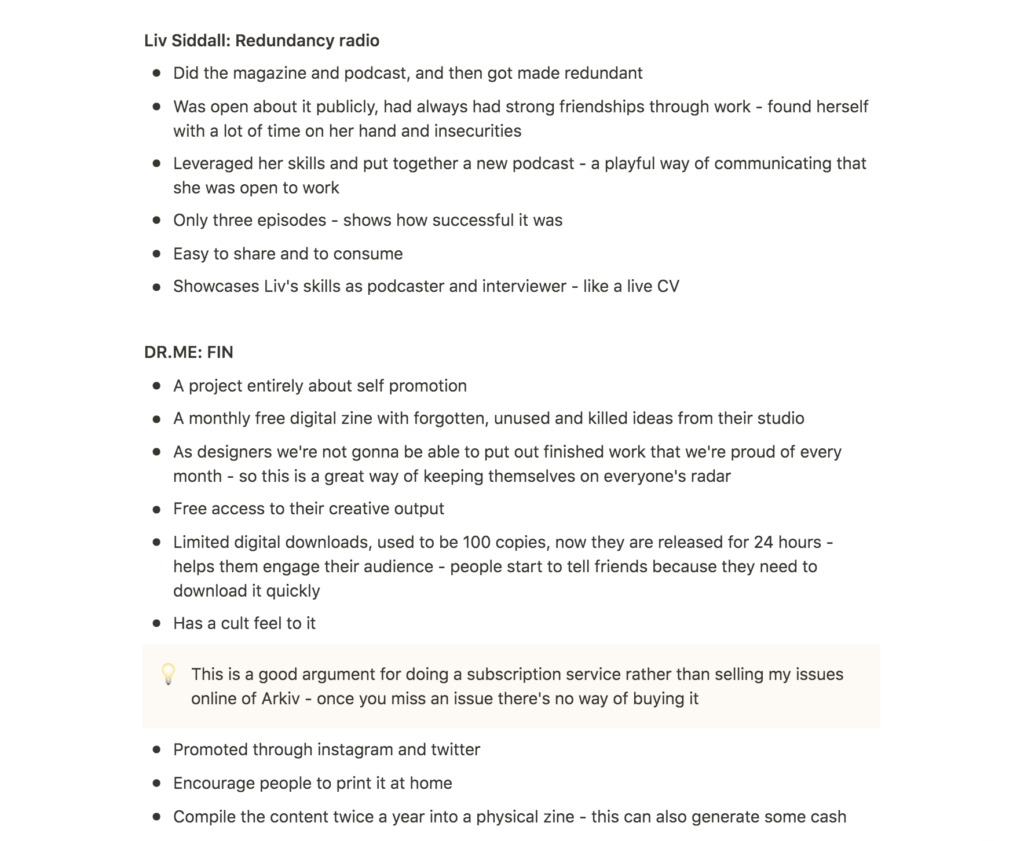
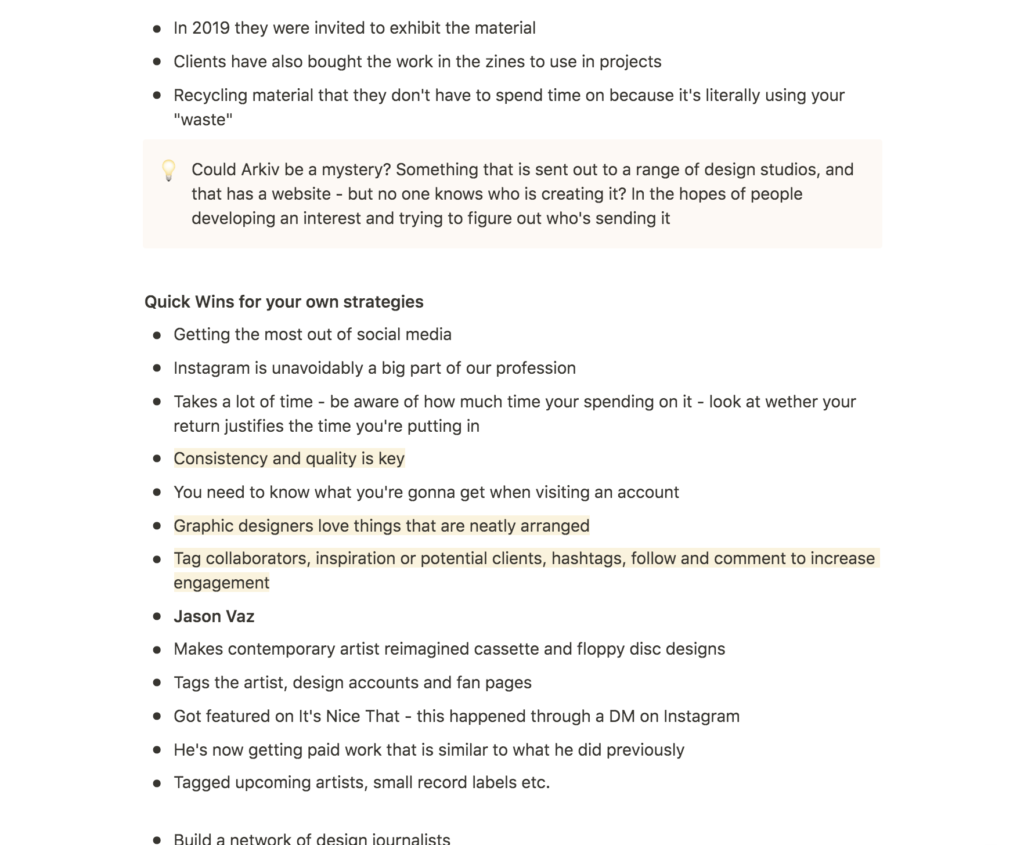
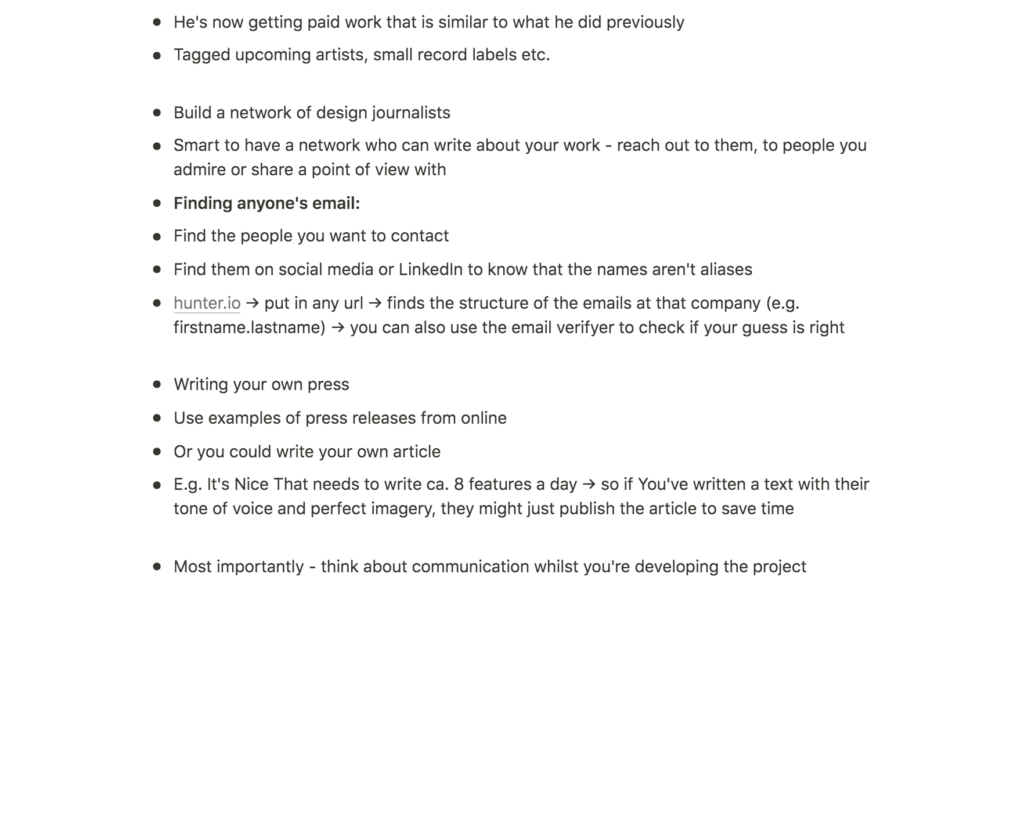
Lecture reflections
I loved this week’s lecture by Alec Dudson and his many valuable insights on marketing. Firstly the information of writing press releases, and the importance of saying something different across multiple channels was helpful (Alec Dudson, 2019). This seems like a large amount of work and I can see how it would be beneficial to use a PR company. However, Dudson’s advice on not having to discuss your work, but rather discussing issues related to it (Alec Dudson, 2019) was great advice if deciding to do it on your own. In terms of my product, Arkiv, I could write about how taking inspiration from social media is problematic due to the use of algorithms.
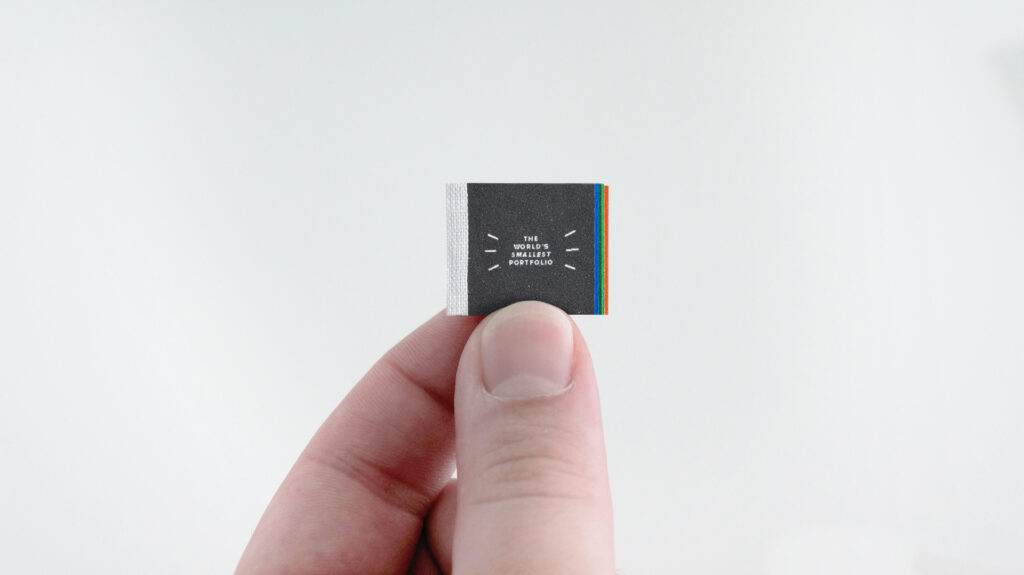
Could Arkiv promote myself as a designer?
Michael Lester’s The World’s Smallest Portfolio was a great project and I love how the marketing and product spurred out from one simultaneous idea (Alec Dudson, 2019). Although it’s not as clear a line between maker and product as Lester’s, I do wonder wether Arkiv could play a similar function for myself as designer. By sending out Arkiv to studios I’m fond of, I might be able to make some contacts, or at least be remembered if I was to get meet them at a later date.
How can I utilise my BA in photography to document my work?
Dudson’s point about beautiful documentation was also a good point, and it made me reflect upon my own portfolio. Although I have a BA in photography, I haven’t spent much effort photographing my own work (mainly due to it consisting of mockups and no physical products). However, Dudson has really inspired me to have a think about documentation, and particularly in regards to Arkiv, as it would need to look good online in order to build a following.
Creating hype through limitedness & mystery
Lastly, DR.ME’s FIN was very inspirational in terms of it’s limitedness. The case study made me wonder wether I could adopt a similar way of thinking for Arkiv. Since my product is a subscription service, it has a sense of limitedness to it as well, particularly if I don’t sell any previous editions. The audience would need to subscribe before it’s sent to print, because I’d only be printing the exact amount of subscribers.
These reflections also made me wonder wether Arkiv could adopt a sense of mystery, in order to create a hype. For example, I could send out free versions of the pamphlet to selected design studios (say for around 6 months) without any information about who’s making it. This way people would have to do some digging, perhaps in collaboration with peers and colleagues.
Resource notes


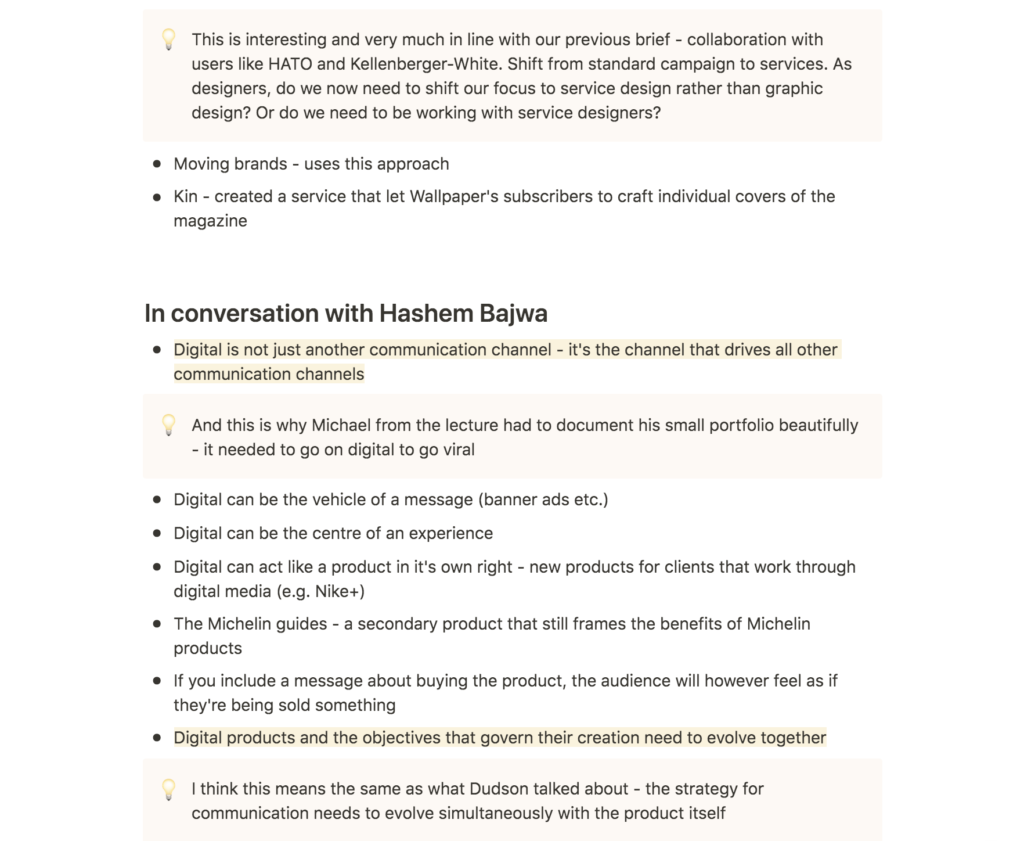
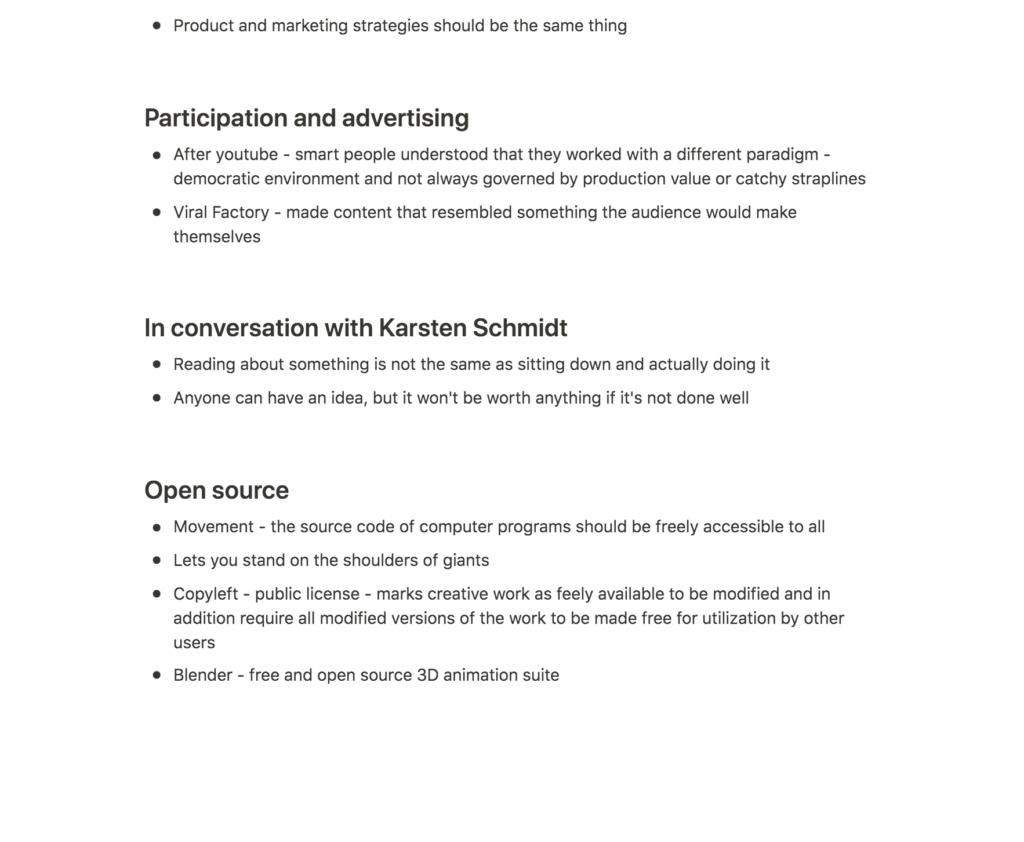
Resource reflections
In the chapter Behavioural Change Price and Yates talks about nudges and how they need to be freedom preserving (Jessie Price and Derek Yates, 2015). I thought this was very interesting as I can sometimes jump straight to the typical call to action when doing marketing work, which is not very freedom preserving at all. As I go on to work with marketing this week, I hope to come up with a strategy which uses nudges rather than hard sale strategies.
I further enjoyed how the discussion on digital products and their objectives evolving together (Jessie Price and Derek Yates, 2015) lined up perfectly with this week’s lecture. In order to create communicative experiences or products (rather than the previously common campaign with catchy slogans as discussed in the book) the strategy for marketing and the strategy for product needs to be developed from the same idea (Jessie Price and Derek Yates, 2015). I do wonder wether I could implement this way of working, for example when setting up a website for Arkiv. The website’s primary goal would be to encourage subscriptions, but like any successful website it should also provide value to the user.
Further research
Building a cult brand
Inspired by DR.ME’s digital zine, I wanted to look further into building a cult brand.
In the entrepreneur.com article 3 Strategies to Create a Cult Following for Your Business, Jess Ekstrom presents three strategies.
The first strategy is to give your audience something to talk about (Jess Ekstrom, 2015). In terms of Arkiv, this could be the mystery of who’s sending those first issues out (if I was to send without writing my name down), or it could be the excitement of which studio’s it’s being sent to each month.
The second strategy is to make your audience feel as if they’re part of a club (Jess Ekstrom, 2015). This seems to mean that the audience should be in on a secret offering, or that they get insight to exclusive information that isn’t readily available to anyone (Jess Ekstrom, 2015). I’m wondering if I could provide exclusivity by not sharing the Arkiv content online (perhaps I could only show the cover?). I could also prioritise the written piece for each issue by making this a “must read”, for example by prompting slightly controversial points, or including easter eggs into the text somehow. If I was to make Arkiv a mystery in terms of who creates it, this could also be something to talk about amongst designers.
Ekstrom’s third strategy is to humanise the experience (Jess Ekstrom, 2015). As discussed last week, I’d like Arkiv to build a community through the use of social media, for example by focusing on having valuable DM and comment conversations.
In his Medium article, Cult Wars: The Making of a Cult Brand, Jordan Odinsky presents some additional strategies to Ekstrom’s, one of them being to create an enemy (Jordan Odinsky, 2020). Odinsky refers to these enemies as familiar brands that no one really admires (Jordan Odinsky, 2020). As Arkiv attempts to bring forward an alternative inspiration source to social media, I think this could be an interesting alternative to an enemy if it was to have one. I wonder wether Arkiv’s distance to social media could be built further into Arkiv’s ideology and messaging.
Further, Odinsky discusses the velvet rope, referring to an exclusivity ring created by getting influencers to promote the brand (Jordan Odinsky, 2020). The audience would then want to join the cult as a way of discovering and clarifying their individualism (Jordan Odinsky, 2020). As already mentioned, I think it could be good to send out free issues to design studios to get them talking. For other designers, they might be the perfect influencers.
Workshop challenge
Prototype
I was fortunate enough to have had time to build a prototype last week. I did a few adjustments to the back, as I wasn’t to happy about the previous grid, as discussed in last week’s blog post. This led to the result below:
The written piece
Inspired by my readings on building a cult brand, I was eager to adopt the concepts of building an exclusivity ring by getting influencers to promote my product. However, I wasn’t so sure that design studios would use their social media accounts to promote another product. Up until this point, I hadn’t really come up with a concept for the essay section of Arkiv (other than wanting to use it to enlighten and bring up new perspectives). Rather than me writing these texts, I thought it could be a good idea to get other designers to write the piece, focusing on how they source inspiration. The texts should have a connection to the design on display, so the process of choosing a design and choosing a writer/designer should therefore go hand in hand, and the text would still need to present the design.
A possibility could also be to have a mix of other designers and myself writing pieces for separate numbers. This would ensure variation, and it would also give Arkiv a voice which could be used to further promote it’s ideology.
Ideology: Social media as enemy
The concept for Arkiv grew out of issues with finding inspiration from social media. As mentioned, I could therefore use social media as the “enemy”, as an element towards building a cult brand (see further research for context). After the head of Instagram came out on Twitter and stated that Instagram is no longer an image sharing app, I have read several articles that proclaim the death of Instagram. Arkiv’s community could therefore be portrayed as creatives coming together to source inspiration in a post-instagram era, by looking to more unique and non-algorithmic options.
The original Instagram aesthetic was very much based on analogue photography, so I actually like the idea of Arkiv being a sort of “bringing back the original instagram” tool. The analogue photography aspect could be carried on into product photography and other imagery used in the branding and marketing of Arkiv.
Website
Although the main life of Arkiv should take place in the pamphlets, I did want Arkiv to have a website for subscriptions. I also think the website could feature information about the service, as well as content that promotes the Arkiv ideology. As a way of strengthening the Arkiv community, I thought it could be nice for the website to have a community library, where the audience could submit archival design. This would build up under the mission of bringing creatives together to source inspiration in a post-instagram era.
I decided to set up some very simple wireframes in order to illustrate my thoughts. The visuals have been translated from the pamphlet design. I also thought it could be a good idea for the website colours to change according to the current issue.
Images used in prototype:
Fig. 8: Unknown maker. ca. 1940-1945. Spiler [snap struts in packaging]
Fig. 9: Unknown maker. 1982. Oljeprøve [glass, oil]
Fig. 10: Unknown maker. 1988. Stearinlys [wax, cardboard]
Below is also a quick video demonstration of the few wireframes:
Images used in prototype:
Fig. 12: Unknown maker. ca. 1940-1945. Spiler [snap struts in packaging]
Fig. 13: Unknown maker. 1982. Oljeprøve [glass, oil]
Fig. 14: Unknown maker. 1988. Stearinlys [wax, cardboard]
If I had more time I would have liked to work further on incorporating the design system into the website, for example by experimenting with hole punching the images. The web design is very simplistic at the moment, and I also would have liked to work further on features and what the website could provide in terms of experience.
Documentation
As mentioned in the lecture, beautiful documentation of design is important for online promotion, even if the product it self is physical. I wanted to attempt to do beautiful documentation of Arkiv, and started off by looking at some reference photography. As mentioned above, I wanted Arkiv’s imagery to be (or mimic) analogue, since the whole concept is based on vintage/retro design.
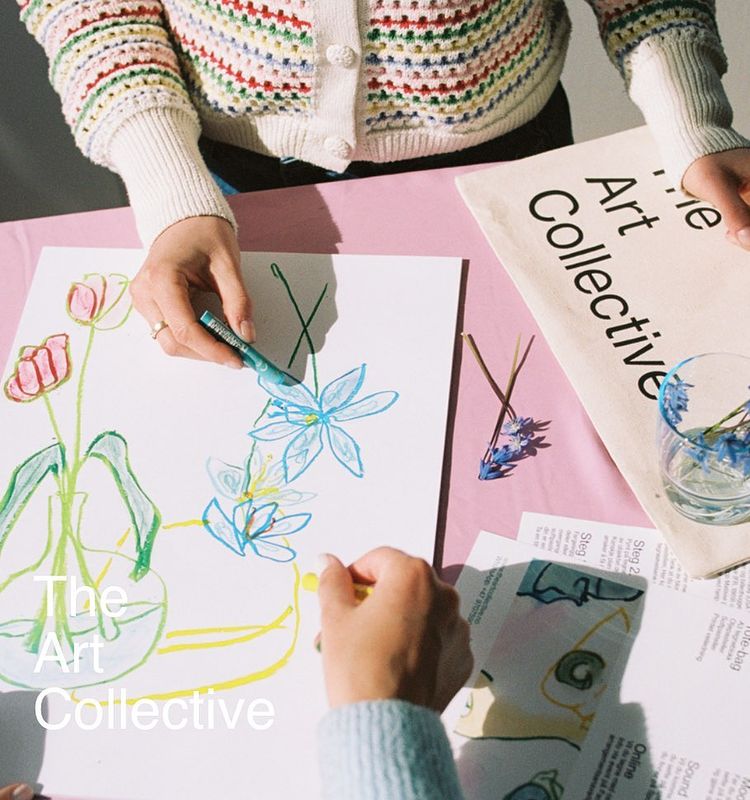
The Art Collective has beautiful photography, filled with sunlight and pastel colours. They seem to mostly use analogue photography, and the aesthetic is very similar to what I imagined for Arkiv.
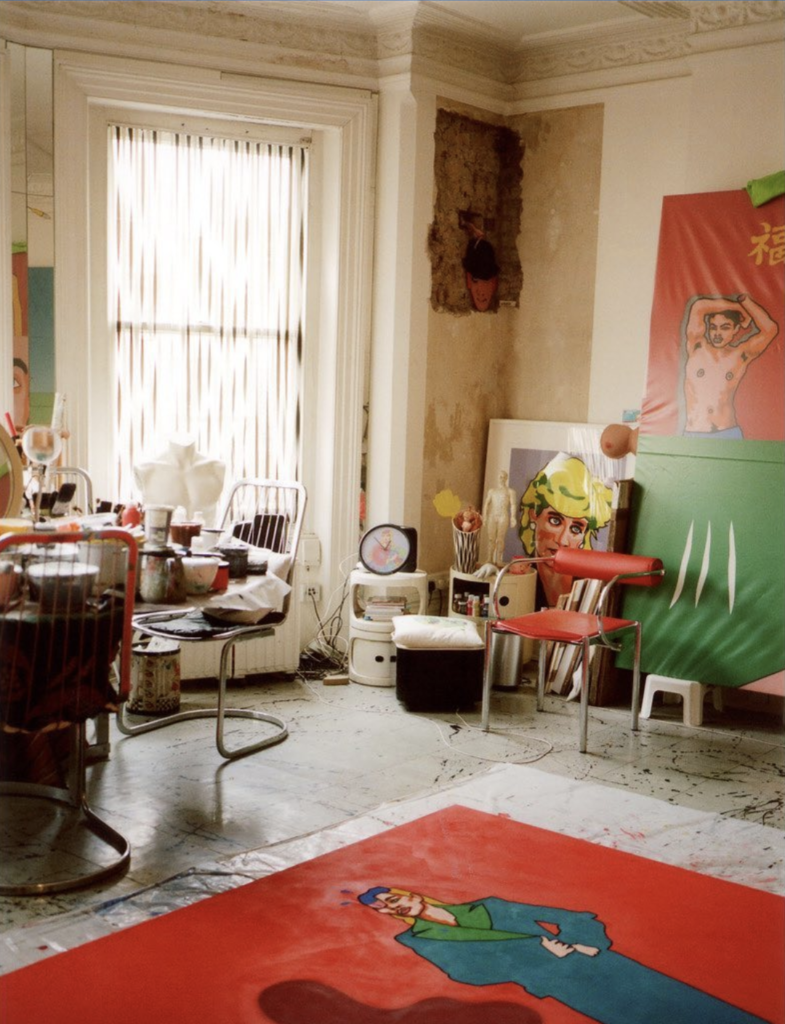
Apartamento Magazine is also a beautiful reference in terms of analogue photography. The colours and textures of their photography is beautiful, and I particularly love their ability to capture spaces that contain traces of living. I think the messy notion of offices and homes would suit Arkiv’s audience, as they identify highly with the role of being a creative (and one’s desk is a huge part of that).
Attempts
Due to time limitations I wasn’t actually able to take analogue images (as they wouldn’t come back in time from the photo lab). I therefore decided to experiment briefly with iphone images.
I wasn’t too happy about the result, and therefore went on to use a digital camera:
I think the bottom image is looking nice in terms of texture and lighting, but the motif isn’t in line with the topic. I ideally wanted the environment to be more designer and office related, but struggled to set up such a set within the timeframe.
If I had more time I would have loved to do a proper shoot with lots of sunlight, audience related props and perhaps someone holding the pamphlet.
Production partners
As mentioned above, I would like Arkiv to invite designers to write the monthly essays. In addition to this, I would need to work with Norwegian archives and get permission to use their designs artefacts in my issues. Lastly, I would need to work with printers, particularly if I was to riso print the pamphlets. A possible partner here could be Hverdag Books, who offers riso printing at an affordable price.
Testing
Since my product is only a pamphlet, I couldn’t really test the usability. Instead, I would have to test the concept, and wether this is something people would be willing to pay for. Simply asking designers if they would buy it seems a bit unreliable as I imagine people saying that they would buy it, even if they wouldn’t actually do it. I have therefore come up with two testing methods.
Sending out pamphlets
As discussed multiple times, I would send out the first issue to selected design studios as part of the marketing strategy. By doing so, I could also track the response. By using Google Analytics I could track the amount of direct visitors, and also buyers who weren’t coming from Instagram. In the beginning, it would be likely that these purchases would come from send outs, as no one would have heard about the service yet.
Another way to track these visits would be to use a QR code with a UTM-tagged link (lets you track visitors who’s coming from one specific channel).
Social media add testing
Another way of testing a service before it’s launch, would be to do an add campaign on social media, that presents itself as if the service was launched. The add would advertise Arkiv subscriptions, and the link would take them to an information page. On the information page, people would be able to sign up to getting noticed when the service is launched. By tracking the amount of sign ups pr. views, I could make an informed decision on demand.
Since sending out pamphlets would mean having a finished issue, and add testing means spending a sum of money, I won’t actually go through with these during this week. If I was to go ahead with Arkiv however, I would think more realistically about these methods.
Promote
Inspired by my readings on building a cult brand, and the lecutre by Dudson, I came up with the following initiatives in the promotion of Arkiv:
- Limited editions
Arkiv is a subscription service, and in order to create a sense of urgency and fear of missing out, buyers will not be able to purchase previous issues. As mentioned by Price and Yates, the fear of loosing something is more influential than winning something (Jessie Price and Derek Yates, 2015). Through social media, Arkiv will remind their audience to subscribe before each issue is sent to print, as there is “no going back” after this. - Getting people to talk about Arkiv
During it’s launch and start up phase, Arkiv will be sent out to selected design studios without any information about who’s making it, or why it’s being sent to that specific studio. The hope is that people will start to talk about who the sender might be, and which studios the sender will ship to next. This will of course only happen if receiver actually cares about the product. - A secret club
As I’m planning on asking designers to write the essay from time to time, selected individuals would grow to learn who makes Arkiv. This information could then start to act as information that isn’t available to everyone, which would make people feel like part of the club (as mentioned by Ekstrom). The community aspect of a club would be brought into the social media strategy, where there would be a focus on carrying out valuable and personal conversations in the comments and DMs. - Exclusivity ring
My audience’s influencers would be other successful creatives. By getting other designers/creatives to contribute to the Arkiv essay, they would act as influencers (which could also be documented on social media). The audience should then want to join the exclusivity ring by subscribing, as a way of finding and stating their individualism (Jordan Odinsky, 2020). - Publishing opinion
In addition to the above, Arkiv could also promote itself by stating it’s opinion on issues related to social media and algorithm inspiration. These texts would not be about Arkiv, but rather contributions to public debate with the Arkiv editorial staff listed as author.
Telling the story
Having established the various points above, I went on to combine this content with the content from last week, in order to tell the story of Arkiv. The task asked for a prototype, which I decided to present in a presentation outline, as I thought this format would work well with the amount of information I aimed to communicate.
Final result
My final result this week is a prototype for Arkiv and a presentation outline with product description, marketing strategy, audience information and reflections on further development.
Arkiv is a pamphlet subscription service that features unknown or forgotten archival references from the graphic design field. It combines the perks of social media (fresh content delivered to you on a regular basis), with the coincidental and perhaps more meditative context of physical books and exhibitions. Arkiv’s mission is to provide an alternative to inspiration controlled by algorithms, and to offer unique references and fresh perspective to fellow creatives.
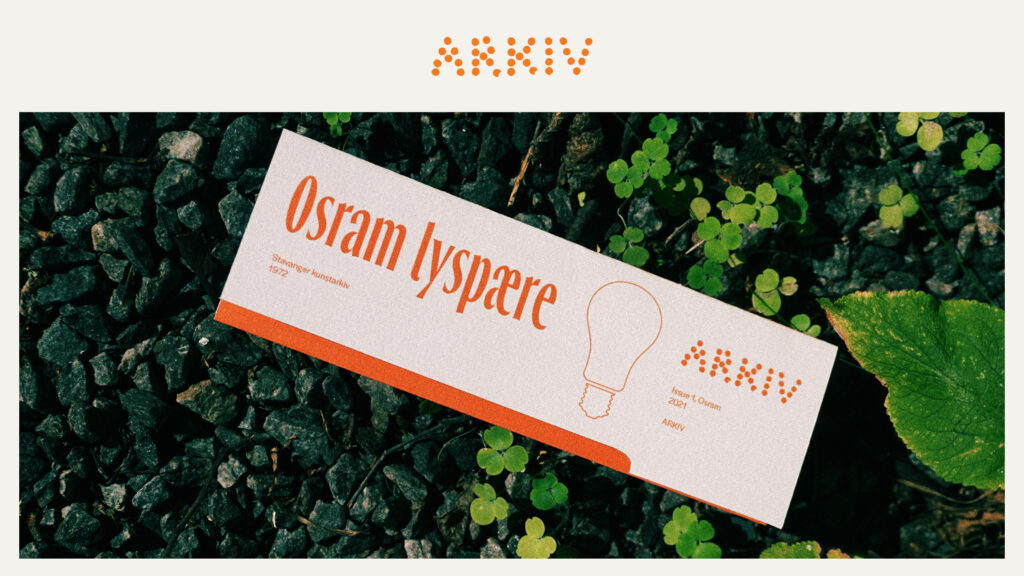
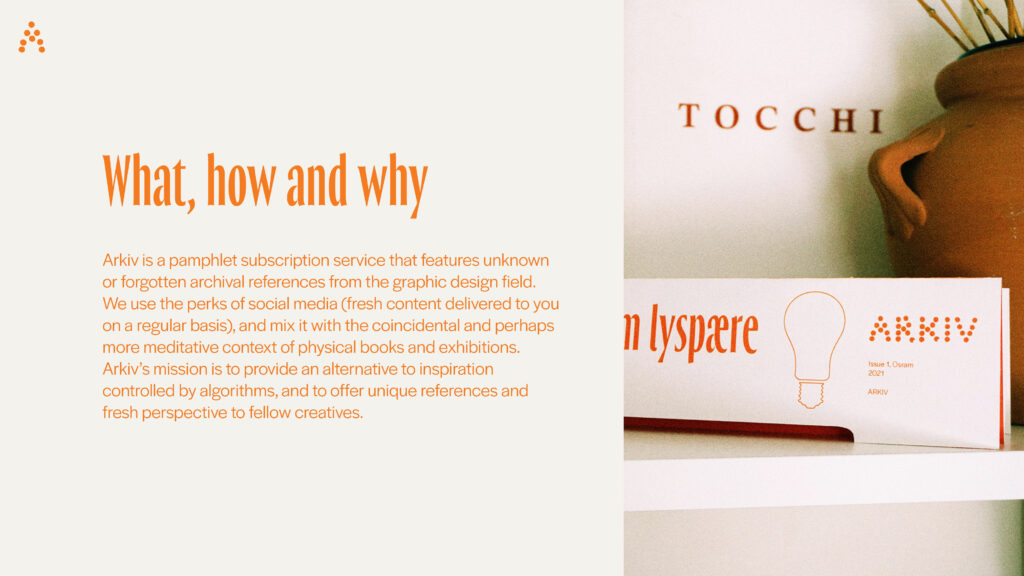

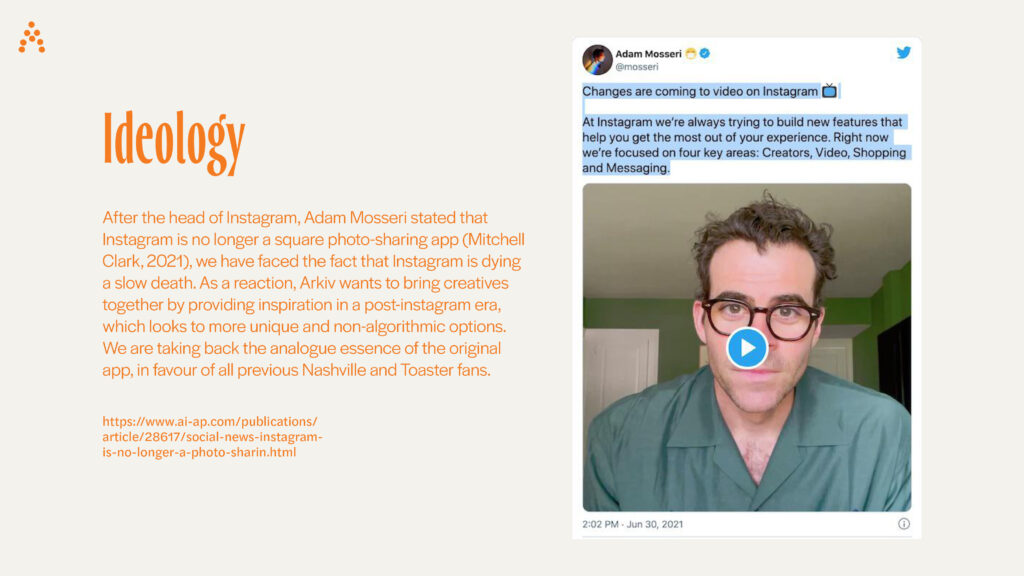
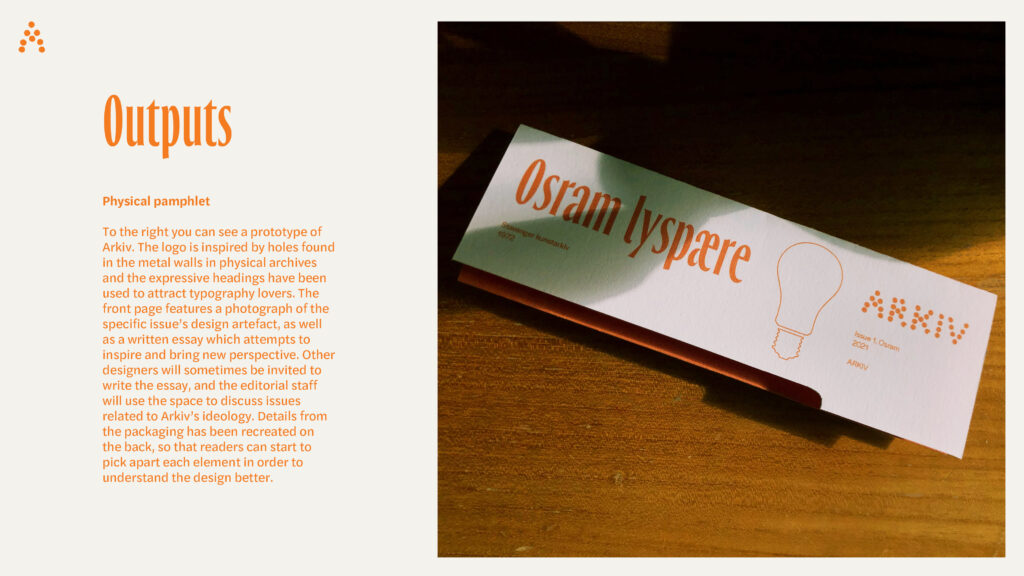
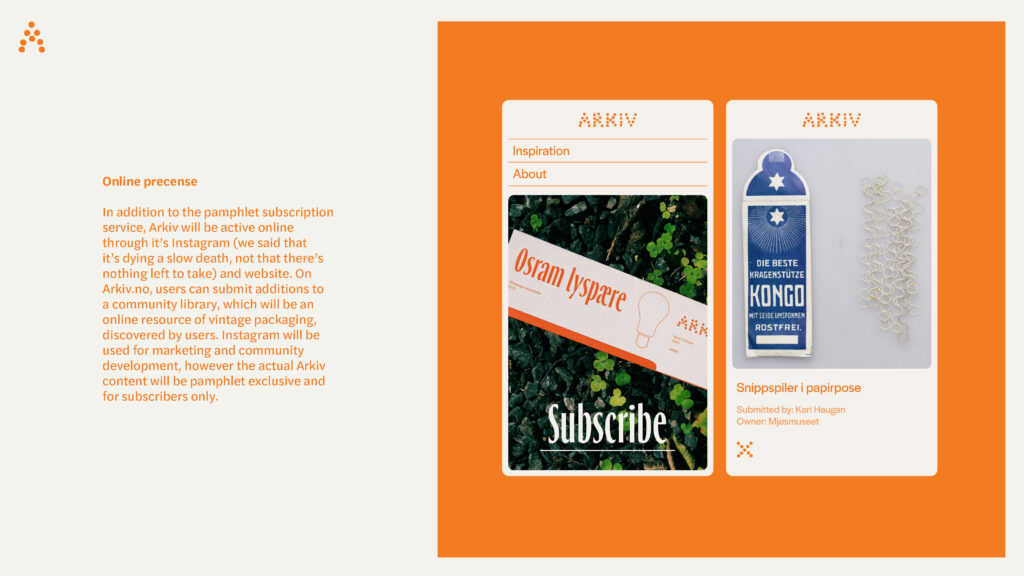
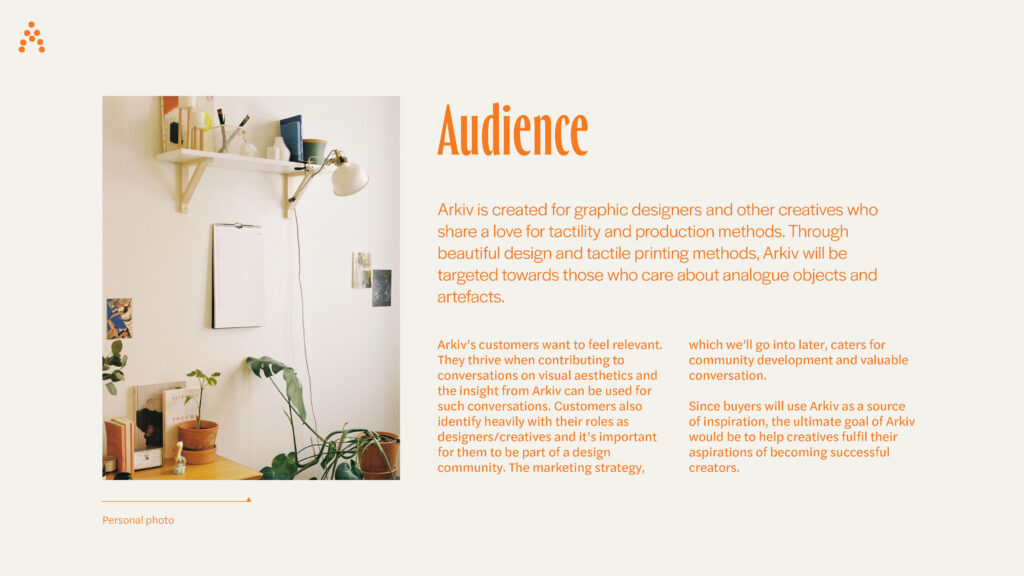
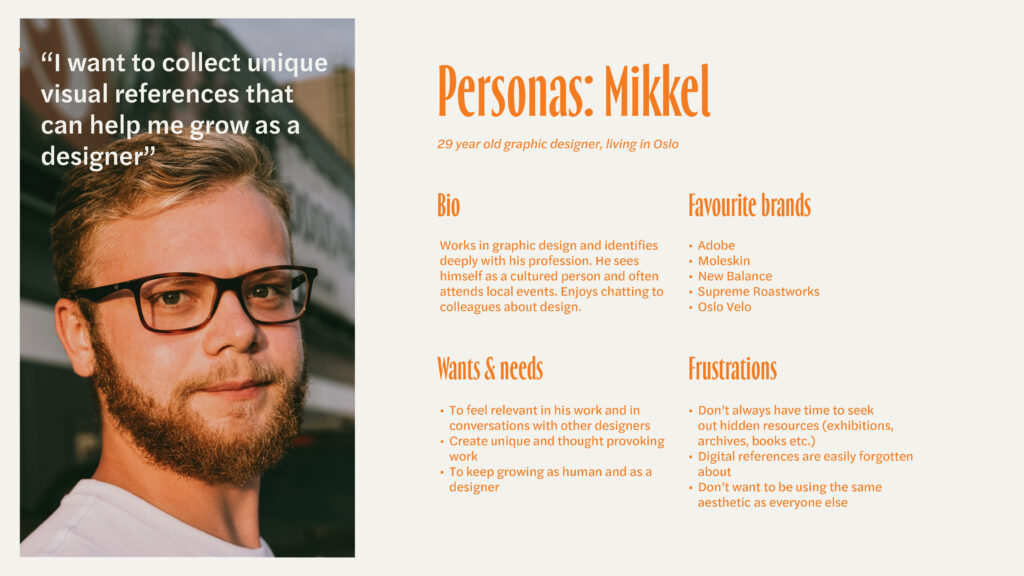
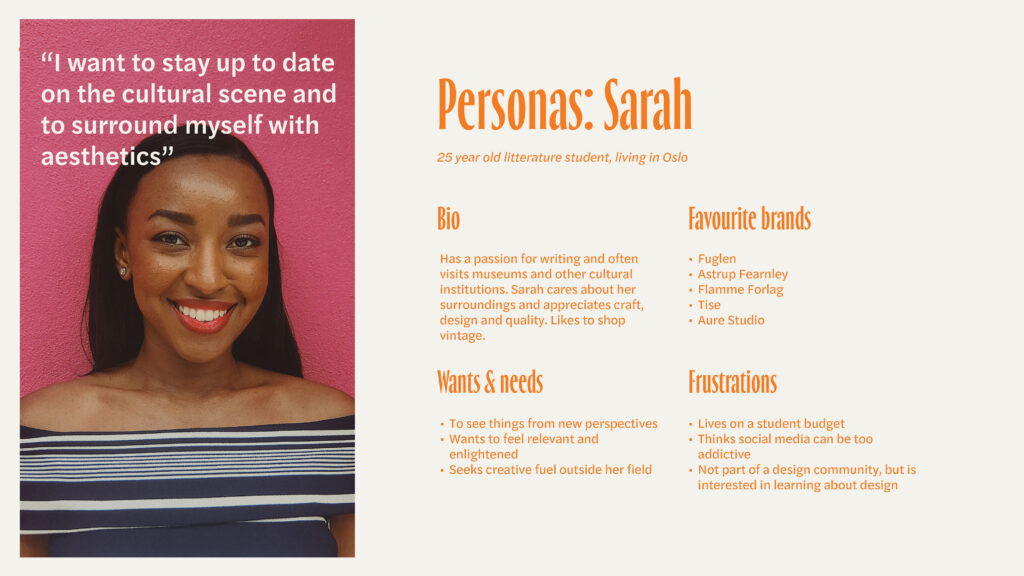
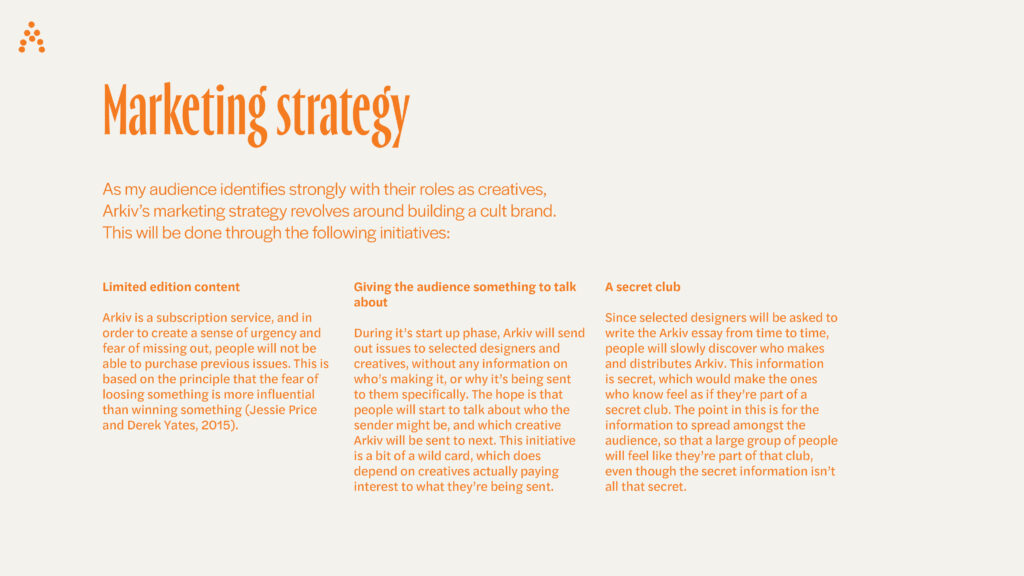


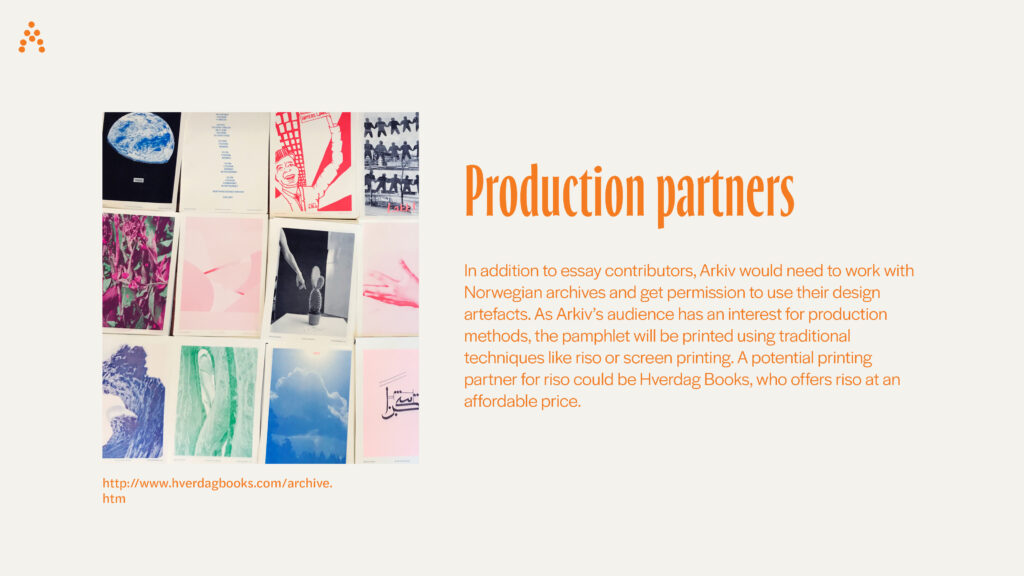
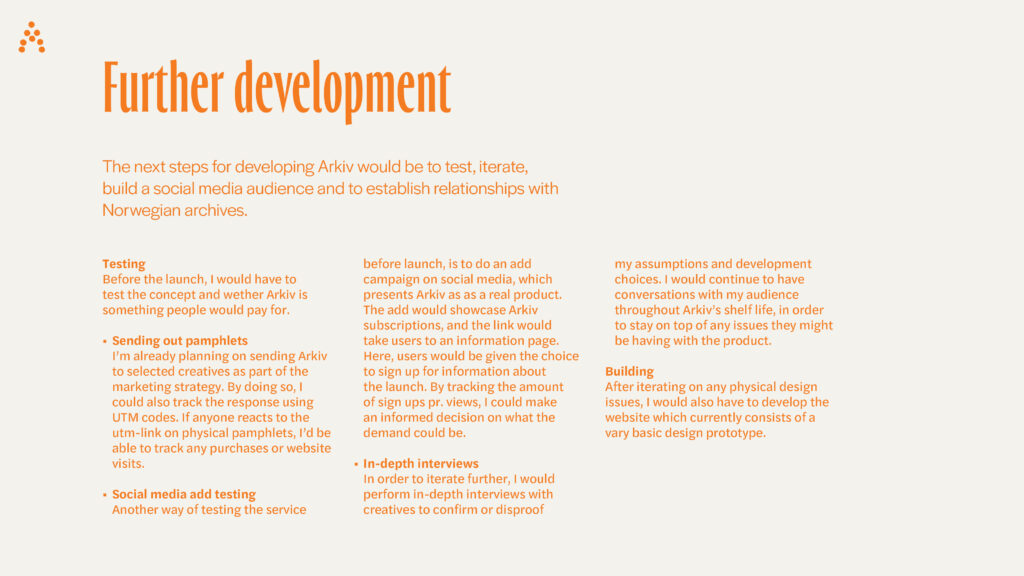
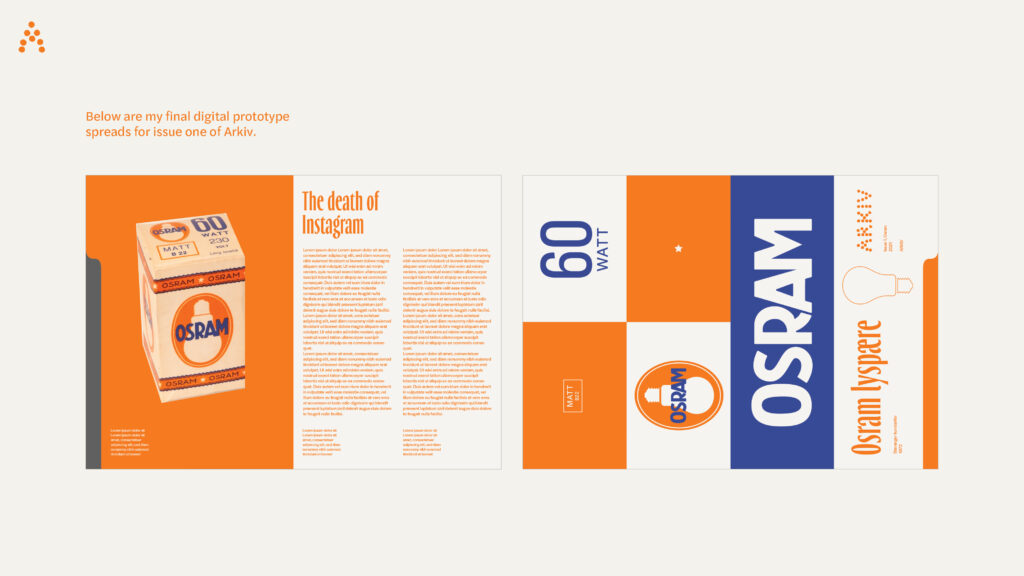
In conclusion
This week has been slightly rushed due to the module deadline, yet it’s been interesting to learn about and work with marketing strategies. Although they could have been better researched, and perhaps tested, coming up with cult brand initiatives made me realise that there is more to branding than tone of voice and visuals. The initiatives are slightly risky, so I would have loved to find out wether they could actually work or not.
In terms of my prototype, I do wish I could have developed it further, perhaps by making a second issue, or by writing the issue one essay. The website prototype is very basic and I also would have liked to work further on that by developing features further. I also think I could have used the hole punch element from the logo in a more cohesive way throughout both physical and digital outputs.
Dudson’s point on the importance of documentation really resonated with me this week. I therefore wish I could have had more time and resources to do product photography of the Arkiv prototype. This could have been done in a designer’s space – something which could resemble a design studio. I also would have loved to do analogue photography, to resonate with the vintage notion of Arkiv.
I’m not sure wether Arkiv is a project I’d like to bring into the world for real, but I have enjoyed learning about the process of developing an authorial project. This is something I might be keen on pursuing in the future, and it’s therefore been a great learning experience that I take with me moving forward.
REFERENCES:
Alec Dudson (2019) ‘Out There: Launches and Promotion’. Canvas Falmouth Flexible [online].
Jess Ekstrom (2015) ‘3 Strategies to Create a Cult Following for Your Business’, Entrepreneur.com, 12 November. Available at: https://www.entrepreneur.com/article/251674 (Accessed: 16 August 2021).
Jessie Price and Derek Yates (2015) Communication design: Insights from the creative industries. London: Fairchild Books.
Jordan Odinsky (2020) ‘Cult Wars: The Making of a Cult Brand’, Medium, 6 August. Available at: https://medium.com/@jordanodinsky/cult-wars-the-making-of-a-cult-brand-152bce93981f (Accessed: 16 August 2021).
Mitchell Clark (2021) ‘Head of Instagram says Instagram is no longer a photo sharing app’, The Verge, 30 June. Available at: https://www.theverge.com/2021/6/30/22557942/instagram-no-longer-photo-app-video-entertainment-focus (Accessed: 16 August 2021).
LIST OF FIGURES:
Figure 1. Michael LESTER. 2015. The world’s smallest portfolio. Behance [online]. Available at: https://www.behance.net/gallery/27389981/The-Worlds-Smallest-Portfolio
Figure 2-3: Ingrid REIGSTAD. 2021. Arkiv issue 1 spreads. Private collection: Ingrid Reigstad.
Figure 4-7: Ingrid REIGSTAD. 2021. Arkiv.no. Private collection: Ingrid Reigstad.
Figure 8. Unknown maker. ca. 1940-1945. Spiler. [snap struts in packaging]. Digitalt Museum [online]. Available at: https://digitaltmuseum.no/021029693549/spiler [accessed 17 August 2021].
Figure 9. Unknown maker. 1982. Oljeprøve. [glass, oil]. Digitalt Museum [online]. Available at: https://digitaltmuseum.no/021029693549/spiler [accessed 17 August 2021].
Figure 10. Unknown maker. 1988. Stearinlys. [wax, cardboard]. Digitalt Museum [online]. Available at: https://digitaltmuseum.no/021029664234/stearinlys [accessed 17 August 2021].
Figure 11: Ingrid REIGSTAD. 2021. Arkiv.no. Private collection: Ingrid Reigstad.
Figure 12. Unknown maker. ca. 1940-1945. Spiler. [snap struts in packaging]. Digitalt Museum [online]. Available at: https://digitaltmuseum.no/021029693549/spiler [accessed 17 August 2021].
Figure 13. Unknown maker. 1982. Oljeprøve. [glass, oil]. Digitalt Museum [online]. Available at: https://digitaltmuseum.no/021029693549/spiler [accessed 17 August 2021].
Figure 14. Unknown maker. 1988. Stearinlys. [wax, cardboard]. Digitalt Museum [online]. Available at: https://digitaltmuseum.no/021029664234/stearinlys [accessed 17 August 2021].
Figure 15. THE ART COLLECTIVE. 2021. No title. Instagram [online]. Available at: https://www.instagram.com/theartcollectiveoslo/
Figure 16. Angelo PANNETTA. 2021. Apartamento Magazine issue 21. Instagram [online]. Available at: https://www.instagram.com/p/CSCEwAYj7OZ/
Figure 17-18: Ingrid REIGSTAD. 2021. Arkiv iphone images. Private collection: Ingrid Reigstad.
Figure 19-21: Ingrid REIGSTAD. 2021. Arkiv digital camera images. Private collection: Ingrid Reigstad.
Figure 22-36: Ingrid REIGSTAD. 2021. Arkiv presentation outline. Private collection: Ingrid Reigstad.
